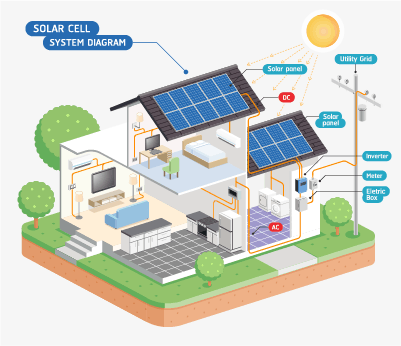Solar power has become one of the most common forms of distributed generation for homeowners.
The ability to utilize open roof or ground space to generate clean, sustainable, and renewable energy has consumers making the switch by the thousands. The idea that panels can produce electricity just by sitting on top of a home is truly astonishing and forcing consumers to ask further questions. Not only is rooftop solar great for the environment, but it is also great for the pocketbook of consumers.
So, what questions must be answered in order to fully understand exactly how solar power works for your home?
- How Does A Solar System Operate?
- What Role Does Net Metering Play In Your Home Solar System?
- What Is A Feed-In Tariff?
- How Can I Figure Out The Payback Period For A Home Solar System?
- What Incentives Are Available For Solar Systems?
How Does A Solar System Operate?
The science behind a solar system producing electricity for a household is relatively simple.

First, light waves from the sun penetrate a solar module or flat-plate collectors mounted on the roof or in a homeowners yard. Then, these light waves excite the electrons within the smaller solar cells. These excited electrons are then transferred via wiring to a solar inverter. This electricity coming out of the solar panels is known as direct current DC. A solar inverter is a device that is able to transfer electricity from direct current DC electricity to alternating current ac electricity which is what homes use to power things like televisions and appliances. AC electricity is useful in the energy industry because it is able to travel much further distances through power lines without losing energy due to resistance in the wiring. Solar energy systems then deliver this ac power to the main electrical panel of a home or business so that homeowners may use the electricity business as usual. Flat plate collectors are very similar in that instead of delivering electricity, they could deliver hot water heating to a home. Regardless of what kind of solar system a homeowner may require for their specific needs, the systems will continue to operate normally as long as the sun is shining. It should be noted that a solar system can still generate electricity when clouds are out because certain wavelengths of light penetrate clouds although it will generate less power than on a sunny, cloud free day.
What Role Does Net Metering Play In Your Home Solar System?
When your home solar system generates electricity, there always need to be somewhere for it to go. In most cases, this final destination for the electricity is your home. However, during the best solar production days of the year, there may be times when your home solar system generates more electricity than your home can handle. This is where the idea of net metering comes in handy. This incentive for solar systems allows a home to generate as much solar energy as it can. If this amount exceeds the amount the home will use, it is then exported to the grid as opposed to being consumed by the house and its appliances. This, in turn, causes your electrical meter to begin to turn backwards. If, by the end of the month, your solar system has exported more to the grid than it has taken off the grid, the electric company will be required to pay you for these excess kilowatt-hours. This feature of a solar system enables homeowners to meet all of their energy needs while even possibly being paid by their local utility.
What Is A Feed-In Tariff?
A feed-in tariff is a policy usually passed by either a state or local government which is designed to encourage stability in the renewable energy marketplace.

This type of tariff guarantees payment for every kilowatt-hour that a solar system produces and exports to the grid for a designated period of time. For example, a particular utility may pass a program that guarantees eight cents per kilowatt-hour for the next twenty-five years. This gives homeowners a high level of assurance that they will receive a fair price when they produce electricity. This allows making the decision to switch to solar to be done with a higher degree of assurance that their investment will be worth it.
How Can I Figure Out The Payback Period For A Home Solar System?
When a homeowner has the ability to generate electricity for themselves, they are far less reliant on pulling electricity from the grid. For every kilowatt-hour that they generate themselves from a ground mounted or rooftop solar system, this is one less kilowatt-hour that they must pay their local utility for. In order to calculate your total payback period for investing in a solar system, a homeowner must closely study their electric bill. There are a variety of charges on this bill ranging from the actual electricity to the generation and transmission costs. Once all of these costs are added together, homeowners can calculate their true cost per kilowatt-hour. This is the offsetting cost that your solar system will save per kilowatt-hour. Next, solar system owners will need to receive an estimate of how many kilowatt-hours their system will produce per year. This can usually be done by the team installing the system. Then, multiply the cost per kilowatt-hour by the total annual production estimate to see the total value of the energy generated. Finally, divide the total installed cost of the system by the annual energy savings value to find out the total number of estimated years the system will take to pay for itself. This time frame differs from state to state depending on the total number of additional incentives that are available.
What Incentives Are Available For Solar Systems?
The single largest financial incentive for homeowners or businesses to install solar energy systems in the Investment Tax Credit (ITC). The federal ITC allows solar system purchasers to take a tax credit equal to thirty percent of the total system cost.

This cost includes all aspects of the solar array such as the panels, all inverters, wiring, and any additional electrical infrastructure upgrades that need to be made prior to energizing the system. One of the great differences between a tax deduction and a tax credit is that a tax credit allows you to lower your tax burden dollar for dollar at the end of the year as opposed to a tax deduction which only lower the amount of income that is being taxed at a normal income tax rate. This saves homeowners thousands of dollar on their solar system and makes the decision to switch much easier. A second financial incentive available to homeowners is the ability to sell Solar Renewable Energy Credits (SRECs). SRECs are bought and sold, much like stocks, by utilities which are required to source a certain percentage of their power from renewable sources. One SREC is equal to one thousand kilowatt-hours of generation. Once these SREC’s are minted, homeowners can sell them to utilities or those seeking to claim renewable energy usage. SREC’s only exist in states which have a Renewable Portfolio Standard (RPS). This RPS is the legislation that sets up an SREC market. The combination of these incentives and other locally available incentives can make the cost of solar even cheaper than power from the utility in certain areas.
Whether you are installing flat-plate collectors or a full solar system, being informed enables you to make the most informed decision possible. By fully understanding how a solar system works paired with the available financial incentives, solar can significantly reduce energy bills and truly work for your home.
